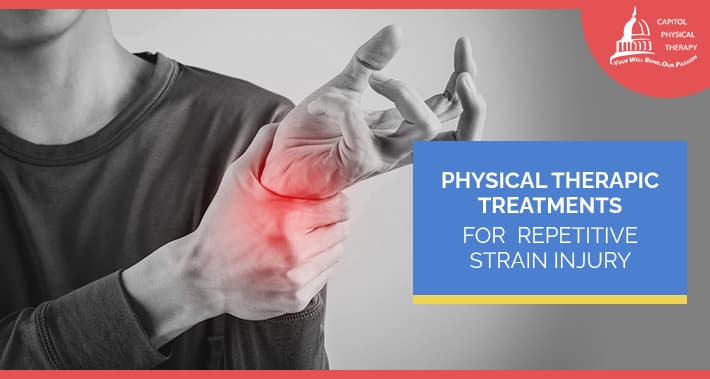
Have you ever experienced pain after doing the same activities over and over?
If so, you’re at least a little familiar with repetitive strain injury and what it can do to your body.
The good news is that repetitive strain injury is just one of many health concerns physical therapy can help with.
At Capitol Physical Therapy, we offer physical therapy in Washington DC for a wide range of physical issues, whether it’s an old sports injury or a new physical condition that has cropped up.
If you’ve been hurt, physical therapy for injury recovery can help you get back to your favorite activities and daily living.
We’ve covered a wide range of topics over the years here on our physical therapy blog, but today we’re looking at repetitive strain injury.
Learn more about repetitive strain injury – what it is, what causes it, and how physical therapy can help.
What Is A Repetitive Strain Injury?
Sometimes, it’s hard to tell the difference between a repetitive strain injury or a pulled muscle.
A repetitive strain injury is an injury that results from repeated movement in the same area of muscles, tendons, and nerves.
The injury causes pain to the affected area and is often the result of everyday activities such as typing, cooking, or grasping tools.
Common Repetitive Strain Injuries
Repetitive strain injuries can happen in almost any area of the body but some are far more common than others.
Here are some of the more common repetitive strain injuries.
1. Carpal Tunnel Syndrome
Contrary to its name, carpal tunnel syndrome has nothing to do with tunnels you can drive through.
It occurs when the median nerve that passes into the hand (also known as the carpal tunnel) becomes compressed from swelling caused by inflammation.
The median nerve or carpal tunnel is what provides sensation to your thumb, index finger, part of the ring finger, and the middle finger.
Inflammation in the area can cause swelling which then presses on the median nerve resulting in pain, tingling, numbness and burning.
This pain not only affects the immediate area but can also travel up the arm.
There may also be a loss of strength in the hand muscle resulting in difficulty gripping or moving the hand in certain ways.
2. Tennis Elbow
You don’t necessarily have to play tennis to get tennis elbow.
Tennis elbow is painful inflammation in your elbow joint.
In some cases, it’s micro tearing of the tendons that join your forearm muscles to the outside of your elbow.
It is also known as lateral epicondylitis because it occurs on the lateral side of the elbow.
Tennis elbow occurs when a muscle known as the extensor carpi radialis brevis (ECRB) muscle, which is located in the forearm, is damaged.
The muscle’s tendons, which attach your muscle to bone, get tiny tears from repeated stress on the area, leading to inflammation and pain.
Over time, the pain in your elbow area can worsen and lead to other symptoms such as pain extending from the elbow down to the wrist, a weak grip, and increased pain when squeezing an object or attempting to open a jar.

3. Rotator Cuff Tendonitis
Rotator cuff tendonitis is exactly what it sounds like, a type of tendonitis that affects your rotator cuff.
It affects the muscles and tendons you use to move your shoulder joint.
This can lead to a condition called impingement syndrome.
Rotator cuff tendonitis can cause a loss of strength and mobility in the arm, pain when trying to raise or lower the arm, a clicking sound in the area, stiffness, and pain and swelling in your shoulder area and side of your arm.
In some cases, rest can relieve your symptoms, but over time they may become more consistent.
4. Bursitis
Bursitis is caused by inflammation of the bursae, fluid filled sacs that are found around your joints.
Bursae surround the area where your bone meets muscles, tendons, and skin.
They help to provide lubrication to reduce friction when your joints move.
Bursitis can cause pain and discomfort as well as limiting the mobility of the affected area.
There are several different types of bursitis based on the area that is affected, including:
- Prepatellar bursitis (around the kneecap)
- Olecranon bursitis (elbow)
- trochanteric bursitis (hips)
- Retrocalaneal bursitis (heel)
In more extreme cases, septic bursitis can cause pain, swelling, redness, and infection.
What Puts You At Risk Of Repetitive Strain Injury?
Studies have shown that repetitive strain injuries can happen in almost any area of the body and can have a big impact on your everyday life.
Some of the biggest risks of getting a repetitive strain injury include:
- Standing for long amounts of time
- Heavy lifting
- Maintaining certain postures for a long time such as holding your arms above your head
- Lack of exercise
- Stressing the same muscle areas through repetitions
You may also be more prone to a repetitive strain injury if you have previously injured the same area that is now being stressed from repeated movement.
Preventing Repetitive Strain Injuries
People in a wide variety of occupations are at risk of getting repetitive strain injury but there are always some steps you can take to help prevent them.
For one, do what your mom and teacher always told you: sit up straight!
Go beyond just sitting up straight, though, and ensure that you have a workplace that is ergonomically correct to avoid bad posture and putting strain on certain areas.
Having an ergonomic setup for your workspace is an integral part of prevention.
Make sure your chair and desk are aligned so that your feet can comfortably sit flat on the floor, thighs are parallel to the ground, and elbows are in line with your keyboard.
If possible, get a standing desk so that you can stand at your desk for 20-30 minutes at a time.
You might also want to invest in a headset if you use the phone a lot so that you can avoid strain on the arm, shoulder, and neck.
It is also crucial to take small breaks away from your work station whether you work at a desk or some other type of job.
Go for a short walk, do shoulder stretches, and wiggle your fingers and toes to get some movement in your body.
Engaging in other kinds of movement and avoiding repetition throughout the day is one of the best ways to prevent repetitive strain injury.
Physical Therapy Treatment For Repetitive Strain Injuries
Based on your specific type of repetitive strain injury, we can develop a treatment plan that will help you reduce pain, improve mobility, and get your life back.
Everybody is different, so your tolerance to different therapies may be different than others.
However, your physical therapist may use a combination of the following treatments:
- Manual therapy
- Splinting
- Postural retraining
- Ergonomic interventions
- Strength training exercises
- Heat and cold therapy
If you have carpal tunnel syndrome, your physical therapist may recommend dry needling.
During the course of your treatment, please ask if you are unsure about any of your exercises.
After, your physical therapist may recommend yoga or pilates to stay active, mobile, and reduce your risk of another injury.
Remember, with physical therapy, consistency is key for you to see the best possible results.
Book Your Appointment With Capitol Physical Therapy Today
Are you noticing pain, stiffness, or swelling in your joints and limbs?
If you think you have a repetitive strain injury, book an appointment with Capitol Physical Therapy today.
When it comes to repetitive strain injury, it is better to have an early intervention than to deal with a bigger problem later on.
Don’t wait until your pain becomes unbearable, call or email us today for your consultation so you can get back on the road to health and mobility.
Book your appointment with Capitol Physical Therapy today.
1331 H St NW #200,
Washington, DC 20005
- https://g.page/capitolptdc
9560 Pennsylvania Ave. # 202,
Upper Marlboro, MD 20772
- https://goo.gl/maps/zjL4NnnuThRhrcS86
Capitol Physical Therapy offers orthopedic and other pain related solutions, with our versitile team of physical therapists in Washington, DC